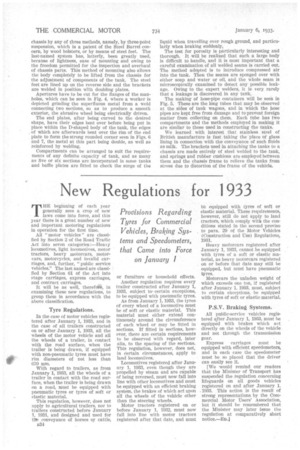New Regulations for 1933
Page 48

If you've noticed an error in this article please click here to report it so we can fix it.
Provisions Regarding Tyres for Commercial Vehicles, Braking Systems and Speedometers, that Came into Force on January 1
THE beginning of each year generally sees a crop of new laws come into force, and this year there is a great number of nevv and important motoring regulations in operation for the first time.
All "motor vehicles" are classified by Section 2 of the Road Traffic Act into seven categories :—Ileavy locomotives, light locomotives, motor tractors, heavy motorcars, motorcars, motorcycles, and invalid carriages, and, further, "public service vehicles." The last named are classified by Section 61 of the Act into stage carriages, express carriages, and contract carriages.
It will be as well, thereto*, in examining these new regulations, to group them in accordance with the above classification.
Tyre Regulations.
In the case of motor vehicles registered after January 1, 1933, and in the ease of all trailers constructed on or after January 1, 1933, all the wheels of the motor vehicle and all the wheels of a trailer, in contact with the road surface, when the trailer is being drawn, if equipped with non-pneumatic tyres must have rim diameters of not less than 670 mm.
With regard to trailers, as from January 1, 1933, all the wheels of a trailer in contact with the road surface, when the trailer is being drawn on a road, must be equipped with pneumatic tyres or tyres of soft or elastic material.
This regulation, however, does not apply to agricultural trailers, nor to trailers constructed before January 1, 1931, and designed and used for fife conveyance of horses or cattle, E34 or furniture or household effects.
Another regulation requires every trailer constructed after January 1, 1933, subject tocertain exceptions, to be equipped with pneumatic tyres.
As from January 1, 1933, the tyres of every wheel of a locomotive must be of soft or elastic material. This material must either extend continuously around the circumference of each wheel or may be fitted in sections. If fitted in sections, however, there are certain requirements to be observed with regard, inter alio., to the spacing of the sections. This regulation, however, does not, in Certain circumstances, apply to land locomotives.
Locomotives registered after January 1. 1933, even though they are propelled by steam and are capable of being reversed, must now fall into line with other locomotives and must be equipped with an efficient braking system, the brakes of which act upon all the wheels of the vehicle other than the steering wheels.
Motor tractors registered on or before January 1, 1932, must now fall into line with motor tractors registered after that date, and must
be equipped with tyres of soft or elastic material. These requirements, however, still do not apply to land tractors, which comply with the conditions stated in the second .proviso to para. 29 of the Motor Vehicles (Construction and Use) Regulations, 1931.
Heavy motorcars registered after January 1, 1933, cannot he equipped with tyres of a soft or elastic material, as heavy motorcars registered on or before that date may still be equipped, but must have pneumatic t'res.
Motorcars the unladen weight of which exceeds one ton, if registered after January 1, 1933, must, subject to certain exceptions, be equipped with tyres of soft or elastic material.
P.S.V. Braking Systems.
All public-service vehicles registered kfter January 1, 1933, must be equipped with brakes which act directly on the wheels of the vehicle and not through the transmission gear.
Express carriages must be equipped with efficient speedometers, and in each case the speedometer must be so placed that the driver can easily see it.
{We 'would remind our readers that the Minister of Transport has suspended the regulation concerning lifeguards on all goods vehicles registered on and after January 1, 1933. This action is the result of strong representations by the Commercial Motor Users' Association, but it should be remembered that the Minister may later issue the regulation at comparatively short notice.—En.]




























































































